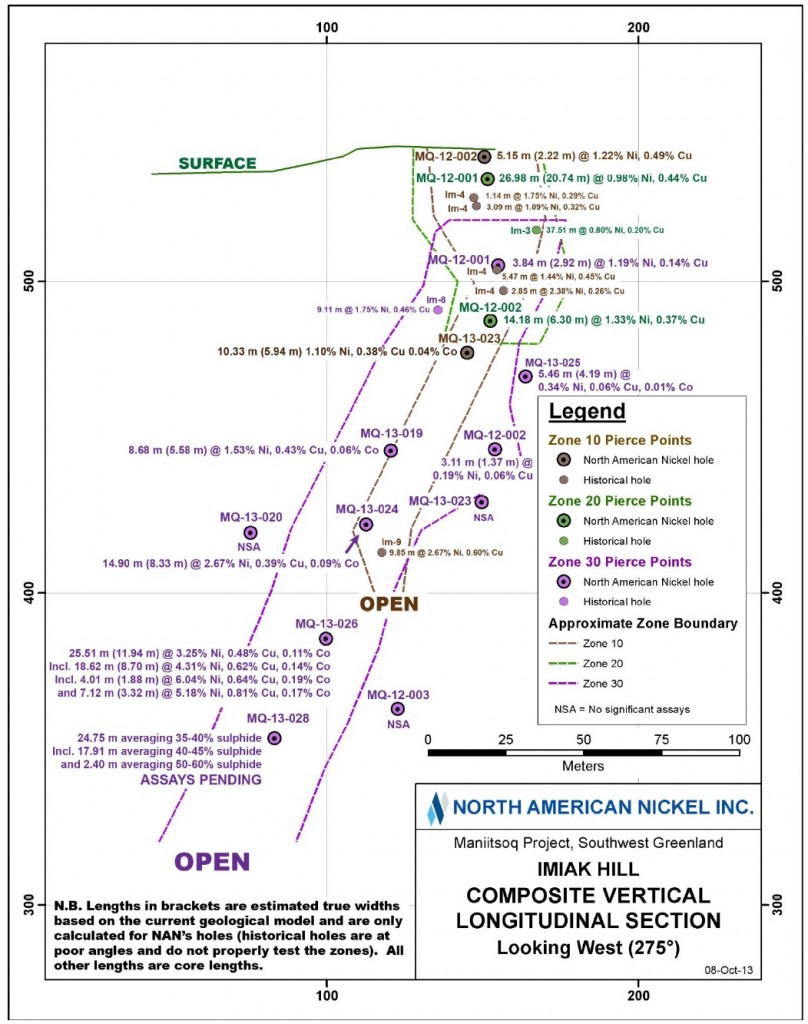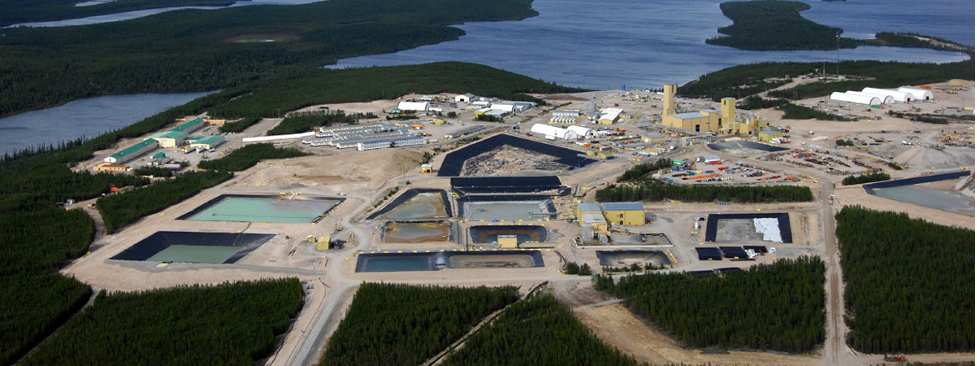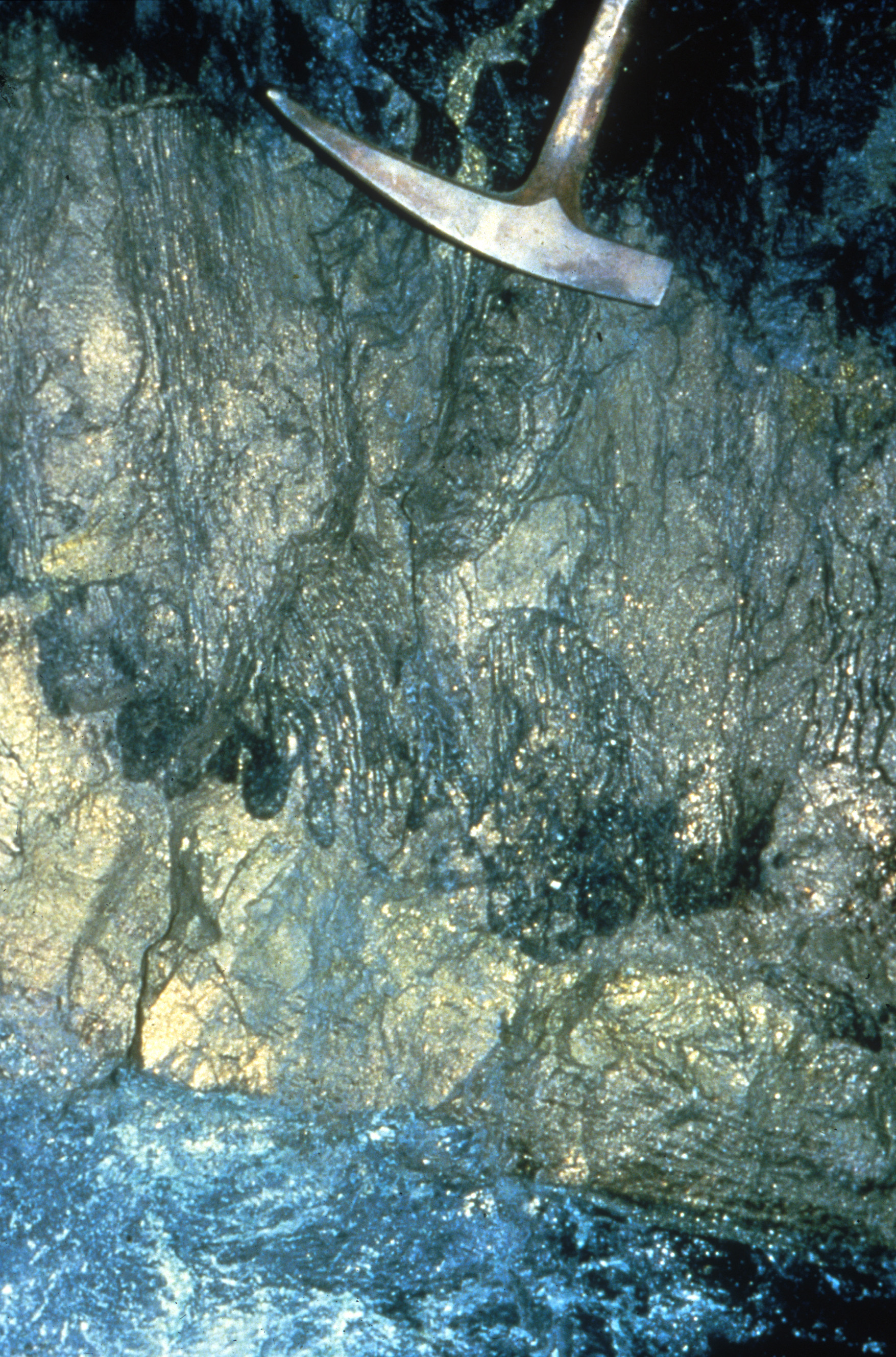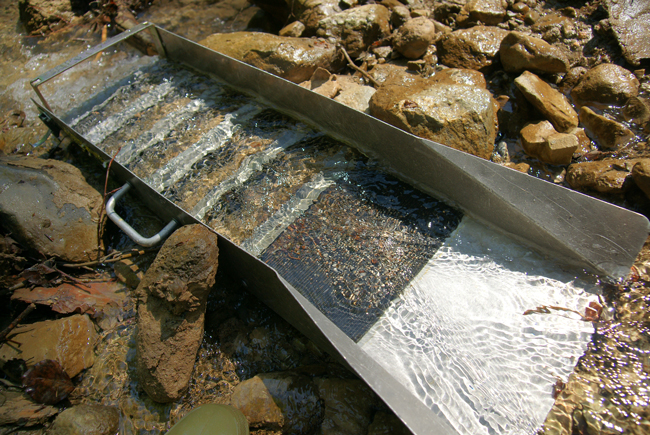These intersections certainly look good. The nickel grades are definitely up there with the best in the world. Together with the reasonably thick intervals make this discovery well worth keeping an eye on.
[box type=”info” align=”aligncenter” ]Disclaimer: This is an editorial review of a public press release and not an endorsement. It may include opinions or points of view that may not be shared by the companies mentioned in the release. The editorial comments are highlighted so as to be easily separated from the release text and portions of the release not affecting this review may be deleted. Please view the full release here.[/box]
MQ-13-026 Intersects 18.62M of 4.31% Ni, Including 7.12m of 5.18%Ni
All Imiak Hill’s 2013 Drill Holes, Regional Exploration Holes MQ-13-010 through MQ-13-017 and 2013 VTEM Flying from Maniitsoq, Southwest Greenland
VANCOUVER, BRITISH COLUMBIA–(Marketwired – Oct. 10, 2013) – North American Nickel Inc. (TSX VENTURE:NAN)(OTCBB:WSCRF)(CUSIP:65704T 108) (the “Company”) is pleased to announce high grade nickel- copper-cobalt mineralization at its Imiak Hill discovery based on results from drill holes MQ-13-019, MQ- 13-024 and MQ-13-026.
Assays of up to 7.06% nickel in MQ-13-026 and 6.26% nickel in MQ-13-024 have been received.
[box type=”note” align=”aligncenter” ]The Imiak Hill discovery is located in the Maniitsoq Project area, Southwest Greenland. Location maps are provided below. Like Sudbury in Canada, the project area is believed to be the site of a very large meteorite impact which hit 3 billion years ago. The remains of the crater produced by the impact is approximately 100 km in diameter. At Sudbury, the nickel sulfides formed when molten sulfide material separated from the molten rock after impact. A similar ore genesis occurred in the Maniitsoq area.[/box]

Imiak Hill is one of three mineralized conduits at the Imiak Hill Conduit Complex (IHCC) located in the northern part of the Company’s 100% owned Maniitsoq Nickel – Copper – Cobalt and PGM project in southwest Greenland (See figure 1 and figure 2).
IMIAK HILL
| Highlights of the Imiak Hill drilling: DDH MQ-13-026: at 149 m down the hole: |
- Intersected 25.51m grading: 3.25% nickel, 0.48% copper, 0.11% cobalt,
- Including: 18.62m of 4.31% nickel, 0.62% copper, 0.14% cobalt
- Including: 7.12m of 5.18% nickel, 0.81% copper, 0.17% cobalt
- Including: 4.01m of 6.04% nickel, 0.64% copper, 0.19% cobalt
- Including: 18.62m of 4.31% nickel, 0.62% copper, 0.14% cobalt
| DDH MQ-13-024: at 136 m down the hole: |
- Intersected 14.90m grading: 2.67% nickel, 0.39% copper, 0.09% cobalt
- Including: 5.23m of 5.03% nickel, 0.30% copper, 0.16% cobalt
- Including: 5.23m of 5.03% nickel, 0.30% copper, 0.16% cobalt
| DDH MQ-13-019: at 118 m down the hole: |
- Intersected 8.68m grading: 1.53% nickel, 0.43% copper, 0.06% cobalt
- Including: 3.56m of 3.27% nickel, 0.66% copper, 0.10% cobalt
[box type=”note” align=”aligncenter” ]These intersections certainly look good. The grades are definitely up there with the best in the world. Together with the reasonably thick intervals make this discovery well worth keeping an eye on.
However, it’s a shame that nickel, copper and cobalt prices are not as strong as they were before the commodities crash of 2008. Back then, cobalt was the most valuable out of the three, fetching $52 USD/lb, nickel $15 USD/lb and copper $4 USD/lb. Nowadays, cobalt is just a little over $12 USD/lb, nickel just above $6 USD/lb and copper is around $3.25 USD/lb.[/box]
Assays for the deepest 2013 hole at Imiak Hill, DDH MQ-13-028, which is below DDH MQ-13-026, are pending. The mineralization at Imiak Hill remains open at depth (see figure 3).
[box type=”note” align=”aligncenter” ]Below we’ve provided a longitudinal section of the drilling. Be careful here! Where it says 35-40%, 40-45% and 50-60% sulfide ASSAYS PENDING, this does not imply similarly high nickel grades. These are visual estimates of the sulfide mineral content, but the iron-sulfide mineral pyrrhotite usually makes up the bulk of the sulfide content in nickel sulfide deposits. Only the assay results will reveal the true grades.[/box]

Assays for the other two mineralized intrusions at the Imiak Hill Conduit Complex, Imiak North and Spotty Hill, are also pending.
NAN CEO and Chair, Rick Mark, states: “It is especially positive that at Imiak Hill that we are seeing stronger grades and widths at depth within a geological setting consistent with our conduit system model of an expected accumulated zone of nickel-copper mineralization in an embayment or footwall contact. Our 2013 drill program at Imiak Hill has now extended the sulphide mineralization from surface to 185m below surface, where it remains open, and assays are still pending for hole 28. The results from our first regional evaluation of the mineralized norites underscores the potential along the 75km-long Greenland Norite Belt. We believe the Maniitsoq project is unique in the world. It is considered a greenfields exploration project, but it is a district-scale, nickel sulphide project that has mineralization starting at, or near, surface containing high grades of Ni-Cu-Co and it is located adjacent to ice free, deep tide water suitable for year round shipping. I offer congratulations to our outstanding technical team, not only for today’s results, but for the constant and impressive advancement at Maniitsoq for the past two and one half years. The future looks just as exciting. We look forward to the upcoming assays from the Imiak Hill Conduit Complex.”
[box type=”note” align=”aligncenter” ]Norite is a coarse-grained mafic igneous rock, very similar to gabbro but containing a different type of pyroxene mineral. Both norite and gabbro are generated beneath the Earth’s crust in the mantle through partial melting of mantle material. When the molten rock ascends and cools, it does so slowly, resulting in the crystallization of coarse mineral grains. Basalts are fine-grained volcanic equivalents of norite and gabbro. The core of the Earth is thought to be composed of mostly iron with around 4-5% nickel. It is believed that nickel is brought to the Earth’s surface via hot plumes within the mantle originating near the Earth’s core-mantle boundary. Due to the deep mantle origin, platinum group metals (PGMs) and gold are present as well. The main nickel mineral in nickel sulfide deposits is an iron-nickel sulfide called pentlandite. Other sulfides present include the magnetic iron-sulfide mineral pyrrhotite, the copper-iron-sulfide mineral chalcopyrite and the iron-sulfide mineral pyrite. Cobalt sulfides are normally quite rare and occur as the minerals cattierite and linnaeite.[/box]
| Table 1. Summary of drill holes with sulphide intercepts and assay results from Imiak hill | ||||||||||||||
| Imiak Hill Zone Holes | ||||||||||||||
| Hole Number |
From (m) | To (m) | Core Length (m) | Ni % | Cu % | Co % | Pt g/t | Pd g/t | Au g/t | TPM g/t (1) |
S % | True_Width (m) (2) | Zone | |
| MQ-13-019 | 112.67 | 113.24 | 0.57 | 5.71 | 1.66 | 0.18 | 0.02 | 0.01 | 0.00 | 0.03 | 27.50 | 0.37 | Imiak Z-20 | |
| MQ-13-019 | 118.09 | 126.77 | 8.68 | 1.53 | 0.43 | 0.06 | 0.00 | 0.00 | 0.00 | 0.00 | 9.42 | 5.58 | Imiak Z-30 | |
| MQ-13-019 | 118.09 | 121.65 | 3.56 | 3.27 | 0.66 | 0.10 | 0.01 | 0.00 | 0.00 | 0.01 | 17.67 | 2.29 | Including | |
| MQ-13-020 | 125.00 | 128.40 | 1.40 | NSA* | Imiak Z-30 | |||||||||
| MQ-13-023 | 75.97 | 86.30 | 10.33 | 1.10 | 0.38 | 0.04 | 0.01 | 0.00 | 0.00 | 0.01 | 6.02 | 5.94 | Imiak Z-10 | |
| MQ-13-023 | 130.00 | 140.00 | 10.00 | NSA* | Imiak Z-30 | |||||||||
| MQ-13-024 | 136.00 | 150.90 | 14.90 | 2.67 | 0.39 | 0.09 | 0.01 | 0.00 | 0.00 | 0.01 | 14.88 | 8.33 | Imiak Z-30 | |
| MQ-13-024 | 136.75 | 141.98 | 5.23 | 5.03 | 0.30 | 0.16 | 0.02 | 0.01 | 0.00 | 0.03 | 26.77 | 2.92 | Including | |
| MQ-13-025 | 93.25 | 98.71 | 5.46 | 0.34 | 0.06 | 0.01 | 0.01 | 0.00 | 0.00 | 0.01 | 2.02 | 4.19 | Imiak Z-30 | |
| MQ-13-025 | 97.10 | 97.64 | 0.54 | 1.39 | 0.16 | 0.06 | 0.01 | 0.00 | 0.00 | 0.01 | 9.56 | 0.41 | Including | |
| MQ-13-026 | 149.81 | 175.32 | 25.51 | 3.25 | 0.48 | 0.11 | 0.01 | 0.00 | 0.00 | 0.01 | 17.77 | 11.94 | Imiak Z-30 | |
| MQ-13-026 | 156.70 | 175.32 | 18.62 | 4.31 | 0.62 | 0.14 | 0.01 | 0.00 | 0.00 | 0.01 | 23.15 | 8.70 | Including | |
| MQ-13-026 | 157.16 | 161.17 | 4.01 | 6.04 | 0.64 | 0.19 | 0.01 | 0.00 | 0.01 | 0.02 | 31.72 | 1.88 | Including | |
| MQ-13-026 | 168.20 | 175.32 | 7.12 | 5.18 | 0.81 | 0.17 | 0.02 | 0.00 | 0.00 | 0.02 | 28.09 | 3.32 | Including | |
| Note: (m) = metres,% = percent, g/t = grams per tonne, NC = not calculated NSA* – no significant assays |
- TPM is total precious metals (gold+platinum+palladium)
- calculated true width based on current 3D model
REGIONAL DRILLING RESULTS
Holes MQ-13-010 through 17 tested seven VTEM targets related to norite intrusions in the central and southern parts of the 75km-long Greenland Norite Belt. Table 3 summarizes the assay results and table 4 lists the collar coordinates of each hole along with the target tested. The map in Figure 4 shows drill hole locations.
Disseminated sulphide mineralization was intersected in noritic rocks at five of the seven targets.
The strongest mineralization occurred in hole MQ-13-016, which tested VTEM target P-22B. The hole intersected 43.82 m of mineralized norite averaging 0.22% Ni including several higher grade intervals, the best was a 1.26m interval assaying 1.44% Ni, 0.34% Cu, 0.05% Co and 0.32 g/t TPM.
Hole MQ-13-017, drilled on the same section and designed to test 40 to 50 metres down-dip of MQ-13-016, intersected much weaker mineralization over narrow intervals. The best assay was 1.92 m at 0.23% Ni. Based on the surface gossan outcrop, it is possible that MQ-13-017 was drilled below the plunge of the mineralization intersected by MQ-13-016. Initial review of downhole geophysics indicates more conductive material lies to the right and above the drill hole, which also fits the interpretation of the drill hole passing under the plunge.
All eight holes were surveyed with a three-component electromagnetic probe. The results will be reviewed in conjunction with geological observations to determine which of the regional targets drilled in 2013 warrant follow-up drilling and/or surface geophysical surveys in 2014.
[box type=”note” align=”aligncenter” ]The company’s regional drill program isn’t nearly as impressive. They were testing targets identified with Airborne Geophysics and are now using DHEM (Down Hole Electro-Magnetics) to try and get a clearer picture of the subsurface and hone in on future drill targets. Though they don’t say specifically what equipment they’ve used, here’s an example of a down hole geophysical probe used for this type of survey.[/box]
| Table 3. Summary of drill holes with sulphide intercepts and assay results from regional exploration on the property | ||||||||||||||
| Regional Exploration Holes | ||||||||||||||
| Hole Number |
From (m) |
To (m) |
Core Length (m) |
Ni % | Cu % | Co % | Pt g/t | Pd g/t | Au g/t | TPM g/t (1) |
S % | True_Width (m) |
Zone | |
| MQ-13-010 | NSA* | P-63 | ||||||||||||
| MQ-13-011 | 31.76 | 35.98 | 4.22 | 0.18 | 0.06 | 0.01 | 0.04 | 0.01 | 0.01 | 0.06 | 1.26 | NC | P-97 | |
| MQ-13-012 | 62.44 | 64.00 | 1.56 | 0.10 | 0.02 | 0.01 | 0.03 | 0.03 | 0.00 | 0.06 | 0.44 | NC | P-30 | |
| MQ-13-013 | 162.00 | 164.00 | 2.00 | 0.13 | 0.03 | 0.01 | 0.01 | 0.01 | 0.00 | 0.02 | 0.56 | NC | P-61 | |
| MQ-13-014 | 47.50 | 48.00 | 0.50 | 0.20 | 0.07 | 0.01 | 0.01 | 0.00 | 0.00 | 0.01 | 1.26 | NC | P-32 | |
| MQ-13-014 | 54.48 | 55.46 | 0.98 | 0.20 | 0.05 | 0.01 | 0.00 | 0.00 | 0.00 | 0.00 | 1.15 | NC | P-32 | |
| MQ-13-014 | 64.00 | 65.00 | 1.00 | 0.20 | 0.04 | 0.01 | 0.00 | 0.00 | 0.00 | 0.00 | 0.64 | NC | P-32 | |
| MQ-13-015 | NSA* | P-22A | ||||||||||||
| MQ-13-016 | 18.65 | 62.47 | 43.82 | 0.22 | 0.07 | 0.01 | 0.02 | 0.01 | 0.01 | 0.04 | 1.27 | NC | P-22B | |
| MQ-13-016 | 18.65 | 21.50 | 2.85 | 0.68 | 0.14 | 0.02 | 0.07 | 0.02 | 0.02 | 0.11 | 3.30 | NC | including | |
| MQ-13-016 | 34.55 | 35.23 | 0.68 | 1.24 | 0.23 | 0.04 | 0.14 | 0.04 | 0.01 | 0.19 | 6.36 | NC | including | |
| MQ-13-016 | 48.30 | 49.56 | 1.26 | 1.44 | 0.34 | 0.05 | 0.20 | 0.05 | 0.07 | 0.32 | 7.92 | NC | including | |
| MQ-13-017 | 69.08 | 71.00 | 1.92 | 0.23 | 0.07 | 0.01 | 0.02 | 0.01 | 0.01 | 0.04 | 1.78 | NC | P-22B | |
| Note: (m) = metres,% = percent, g/t = grams per tonne, NC = not calculated NSA* – no significant assays |
- TPM is total precious metals (gold+platinum+palladium)
Drill core assay results are evaluated as part of a Quality Assurance and Quality Control procedure that includes the use of multi-element, certified standards with known precious and base metal values, blank standards and control charts to determine accuracy and precision of analytical results. Core sample analysis was completed by ALS Scandinavia AS of Ojebyn, Sweden. Three methods of analysis were used to determine element concentrations in the rock samples submitted to ALS. These were 1. A multi- element scan, subsequent to a four-acid digestion and ICP/ICP-AES finish; 2. Au, Pt and Pd lead fire assay on a 30 gram sample with ICP-AES finish; and 3. Samples with >1.00% Ni or Cu were re-analyzed by ICP-AES calibrated for ore grade detection limits. Samples with >0.50% S were re-analyzed by Leco furnace and infrared spectroscopy.
[box type=”note” align=”aligncenter” ]This is a tidy statement about their QA/QC procedures. It provides a level of confidence to the investor reading the press release that North American Nickel are following a sound QA/QC program. Here is more information on how and why we have QA/QC programs.[/box]
2013 VTEM FLYING SUMMARY
In 2013 NAN flew an additional 917.3 line-km of VTEM helicopter borne time domain electromagnetic and magnetic surveys over portions of the Maniitsoq property. A total of nine flight blocks were surveyed. They covered norite and other mafic-ultramafic intrusions outside the Greenland Norite Belt (GNB) as well as areas within the belt that required more detailed surveying. Significant new conductors were identified in the Pingo norite intrusion, situated about 14 km north of the GNB; in areas to the south and southeast of the GNB; and, within the GNB itself. These new conductors are currently being evaluated in preparation for next year’s drilling program.
[box type=”note” align=”aligncenter” ]VTEM is useful for detecting and discriminating between moderate to excellent conductors. These types of conductors include semi-massive to massive nickel sulphide deposits. VTEM measurements have a high signal to noise ratio due to the low operating frequency. This enables penetration through conductive surface sediment and rock with depth penetrations of up to 300 metres. For an overview of airborne geophysical techniques including VTEM refer to our article.[/box]
The Maniitsoq nickel-copper-cobalt & PGM project in southwest Greenland contains the 75km-long Greenland Norite Belt (GNB) and is 100% owned by North American Nickel.
Qualified Person
All technical information in this release has been reviewed by Dr. Mark Fedikow, P.Geo, who is the Qualified Person for the Company and President, North American Nickel Inc.
About North American Nickel
North American Nickel is a mineral exploration company with 100% owned properties in Maniitsoq, Greenland, Sudbury, Ontario, and the Thompson, Manitoba nickel belt. VMS Ventures Inc. (TSX VENTURE:VMS) owns approximately 23.9% of NAN.
The Maniitsoq property in Greenland is a Camp scale project comprising 5,106 square km’s covering numerous high-grade nickel-copper sulphide occurrences associated with norite and other mafic- ultramafic intrusions of the Greenland Norite Belt (GNB). The 75km-longplus long belt is situated along, and near, the southwest coast of Greenland, which is pack ice free year round.
The Post Creek/Halcyon property in Sudbury is strategically located adjacent to the producing Podolsky copper-nickel-platinum group metal deposit of Quadra FNX Mining. The property lies along the extension of the Whistle Offset dyke structure. Such geological structures host major Ni-Cu-PGM deposits and producing mines within the Sudbury Camp.
[box type=”success” align=”aligncenter” ]Have a company or release you’d like us to look at? Let us know though our contact page, through Google+, Twitter or Facebook.[/box]






